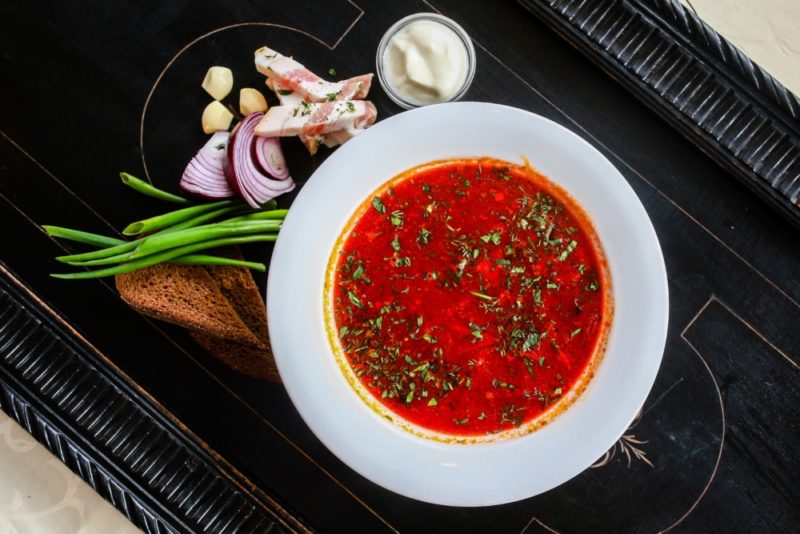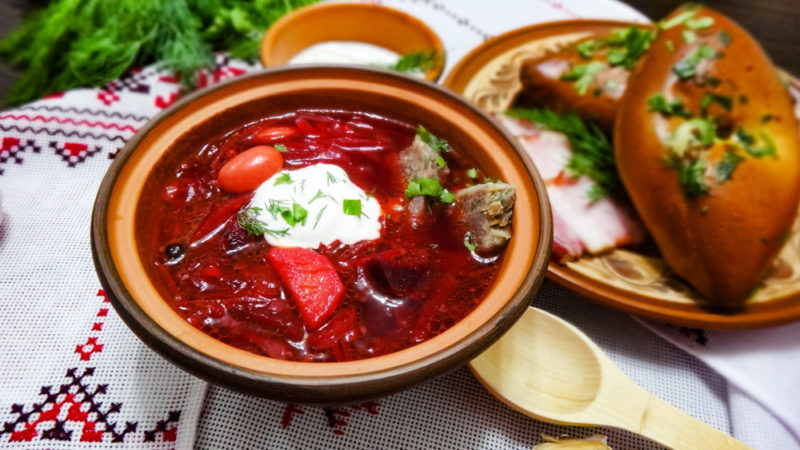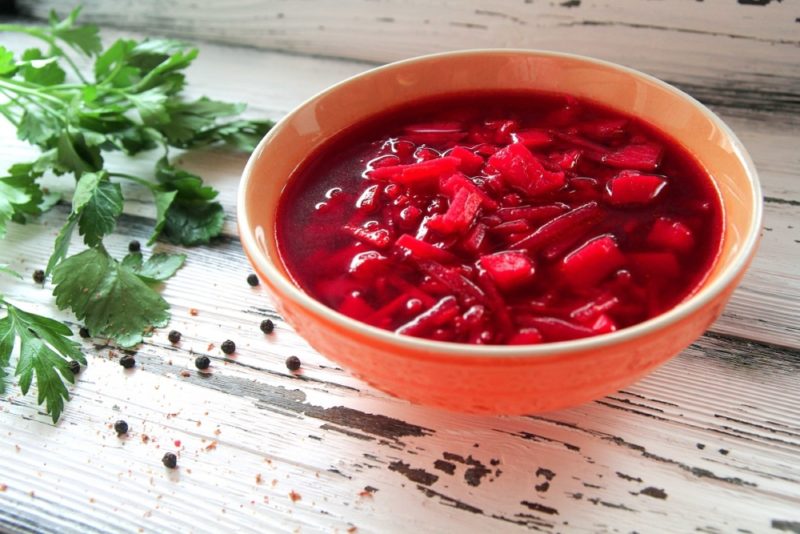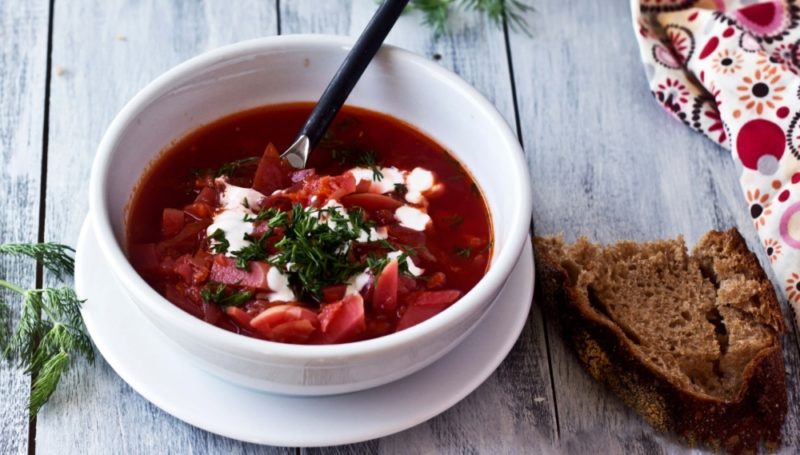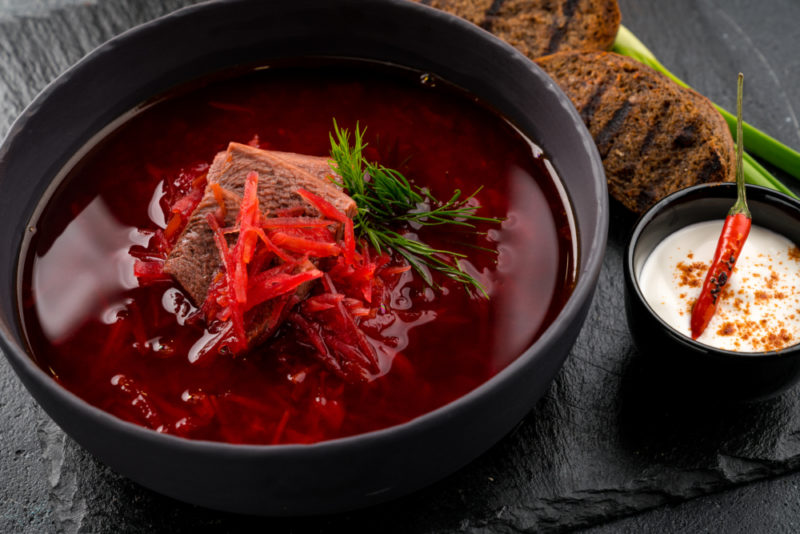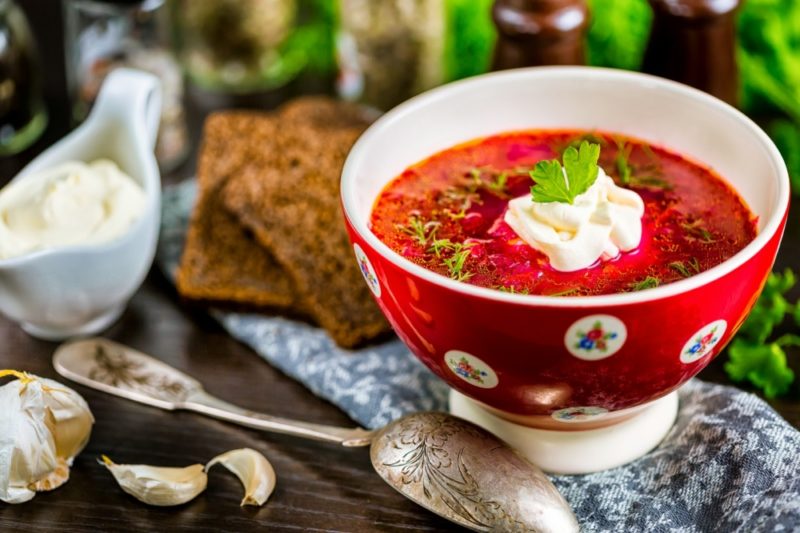In this article, we consider the calorie content of borsch - the most popular dish of the countries of the former USSR. There are a lot of recipes for this soup, we will understand the nutritional value of the most popular variations of the first dish. And also find out how you can increase or decrease the content of kcal in a serving.
Material Content:
Chemical composition and nutritional value
Depending on the composition of the soup, its nutritional value will vary. The classic recipe involves beef - a storehouse of protein, vegetables - a variety of vitamins and minerals. Despite the fact that borsch is a very satisfying dish, its calorie content is low.
Consider the nutritional value and chemical composition of a dish if the following products are present in it:
- beef;
- carrot;
- onion;
- beet;
- White cabbage;
- parsley;
- tomato paste;
- sunflower oil;
- sugar;
- vinegar;
- salt.
Nutritional value per 100 g:
- kcal - 60-150 (depending on meat, with fat or not);
- proteins - 3.8 g (almost 4% of the daily norm for an adult);
- fats - 3 g (5% of the daily requirement);
- carbohydrates - 4.8 g (about 5% of the daily intake);
- dietary fiber - 1 g (5% of daily requirement).
The chemical composition includes many vitamins (groups B, P, retinol, C, D, E, biotin, PP) and trace elements (potassium, calcium, magnesium, sulfur, phosphorus, chlorine, aluminum, vanadium, iron, iodine, lithium, cobalt , copper, molybdenum, tin, zinc, chromium, rubidium, fluorine).
Cholesterol in 100 g of borscht is only 5 mg, and per day you can consume no more than 300 mg.
Calorie meat and lean borscht
The calorie content of borscht largely depends on what type of meat is used to create it. Consider the content of kcal in 100 grams of your favorite soup with different options for its preparation.
First of all, we will analyze the dish on beef broth.Calorie counting is simple, you need to consider each product, add up the results.
Per 100 g kcal:
- beef - 250;
- beets - 43;
- carrots - 32;
- onions - 40;
- potatoes - 77;
- tomato paste - 82;
- white cabbage - 25;
- sunflower oil - 884.
Now let's calculate the number of calories by weight of the product taken for cooking:
- meat 300 g - 750;
- beets 100 g - 43;
- carrots 50 g - 16;
- onions 25 g - 10;
- potatoes 100 g - 77;
- tomato paste 25 g (tablespoon without slide) - 20.5;
- cabbage 300 g - 75;
- oil 50 g - 442.
There are no calories in salt, pepper and water. Add up the number of calories, and we get a total of 1433.5 kcal. In total, we took products for 950 g, 100 g of them will be 150 kcal, but we do not put on the plate only the thick component of the soup, but together with the broth. therefore calorie borsch with beef per 100 g on average 70-100 kcal.
Borsch with chicken:
- chicken breast - 165 kcal per 100 g;
- the rest of the ingredients are the same.
We calculate calories:
- poultry meat 300 g - 495 kcal;
- oil 50 g - 442;
- beets 100 g - 43;
- onions 25 g - 10;
- carrot 50 g - 16;
- potatoes 100 g - 77;
- tomato paste 25 g - 20.5;
- white cabbage 300 g - 75.
We summarize kcal, we get 1178.5 calories per 950 grams of product. And this is 124 kcal per 100 g. In 100 grams of borscht on chicken stock will be 60-80 kcal.
Meat is not included in the recipe for lean soup, it turns out less caloric.
We calculate the energy value of 100 g of borsch on vegetable broth:
- vegetable oil 50 g - 442;
- beets 100 g - 43;
- turnip 25 g - 10;
- carrots 50 g - 16;
- potatoes 100 g - 77;
- tomato paste 25 g - 20.5;
- cabbage 300 g - 75.
In total, 683.5 kcal came out for products weighing 650 g, and this is 105 kcal per 100 g. That is, a portion 100 g of lean borsch contains 50-70 kcal (depending on the density).
Daily rate of consumption of the product
Depending on what lifestyle a person leads, the number of required calories varies.
How much energy is needed:
- If you have a sedentary job, you do not play sports, then about 2500 kcal per day for normal life activities
- For people engaged in hard work, the norm is 4000-5000 kcal, and those who play sports need even more energy.
To ensure the norm, borscht per day can be consumed quite a lot. As we found out, in 100 beef soup contains 70-100 kcal, in chicken - 60-80, and in lean - 50-70. It turns out that for those who want to lose weight, you can eat their fill of this dish, and the extra pounds will still go away. But for people who want to maintain mass, or even increase it, eating only borsch is harmful, they will not be able to achieve the desired result.
Next, we learn how to lower or increase the energy value of borsch.
Ways to reduce and increase calories in a dish
If you want to lose weight, then you can safely eat borsch.
There are many ways to reduce calorie content:
- Cook lean chicken soup, on the bone, or without meat at all.
- By the readiness of the broth, the meat can be removed, only 20% of the calorie content of beef or chicken will remain in the calorie liquid.
- Despite the fact that vegetable oil is used, its calorie content is high. But borsch will not be tasty if you do not take fried vegetables for cooking. There is a secret to reduce calorie content, after frying, put the onions and carrots on a paper towel, dry them with oil, and drain the remainder from the pan. Thus, we can remove excess calories, because only half of the fat is absorbed into vegetables, which is about 200 kcal instead of 440.
- Do not add sour cream (206 kcal per 100 g) or mayonnaise (680 kcal per 100 g) to the soup.
- When the soup is cold, a crust of fat forms on it. Remove it, and this will reduce calories as much as possible!
Eat dark sorts of bread with borsch, or even better, replace them with bread rolls or completely abandon these products.
People with low weight can build weight by consuming more calories. And workers in physically demanding professions need more energy.
You can increase the calorie content of borsch in several ways:
- For cooking soup, you can use pork with layers of bacon. Fat contains 787 kcal per 100 g (while the calorie content of lean pork is 240 kcal).
- Use mayonnaise to serve soup when serving.
Here can be so different borsch! This soup is for people with any needs, it can be very high-calorie or lean, but in any case hearty. The vegetables that make up the composition will fill the body's need for vitamins and minerals, so borsch is the most useful of soups. We hope this publication will help you cook exactly the first dish that you need. Bon Appetit!


